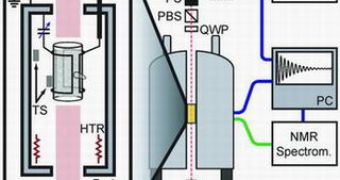Recently, scientists were able to polarize noble gases, (rare gases like Helium, Neon, Argon and Xenon) and to take MRI machine pictures of lungs that had inhaled these gases. A new technique can polarize other elements too, with even greater benefits to medical science. Spin polarization is the degree by which the spin, the intrinsic angular momentum of elementary particles, is aligned to a given direction.
For now, Magnetic Resonance Imaging machines can see protons in body fluids and fatty tissues, but the images are weakly polarized. It could happen for an equal number of spin up protons and spin down ones to make images unreadable.
William Harper, professor at Princeton University, along with student Brian Patton and Kiyoshi Ishikawa, a visiting professor from Japan, were determined to find out if there could be a way to transfer the spin from easily polarized atoms to more reluctant ones.
"There are many other things in the body, from Carbon 13 to sodium chloride in the blood that could provide clues to diseases," says Happer. "Polarizing the nuclei of these elements could make MRIs more effective."
Finally, one of their experiments proved that it is indeed possible to transfer spin polarization from a gas to a solid, and so far they have successfully transferred the spin from a cesium electron to a cesium nucleus.
"The trick," Patton explains, "is to transfer the spin polarization from the electron of a vapor to the nucleus of a solid. This is what we've done with cesium. This is an interesting discovery, because it shows the potential to transfer spin polarization not only from the same type of atom to another of the same atom, but it also provides a way that we might be able to transfer the polarization from one atom to an atom from a different element."
Next, he hopes to be able to transfer polarization from an alkaline metal vapor to the nucleus of a solid, but difficult, metal.
Their discovery could lead the way to various applications, even beyond MRI, like spectroscopy and fundamental physics knowledge.

 14 DAY TRIAL //
14 DAY TRIAL //